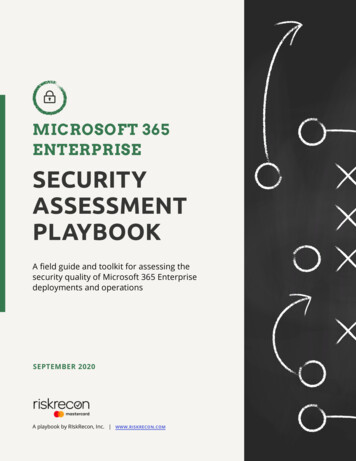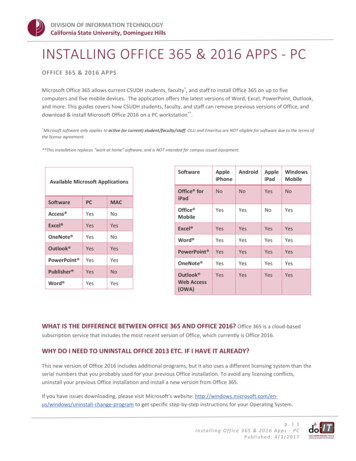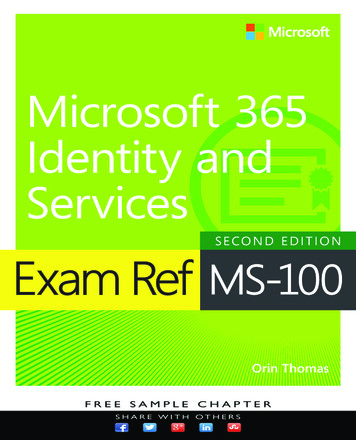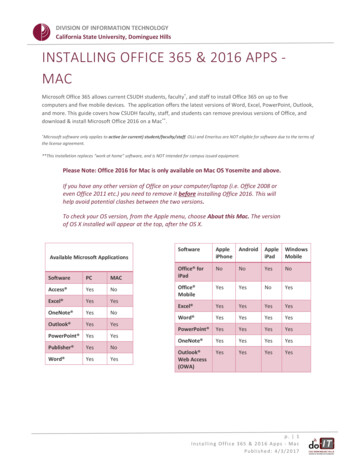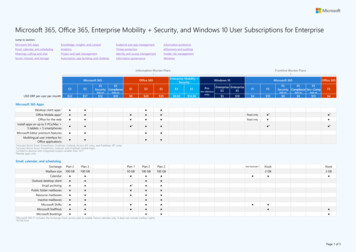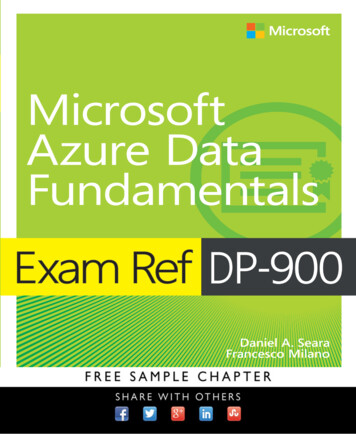
Transcription
Exam Ref MS-900Microsoft 365FundamentalsCraig Zacker
Exam Ref MS-900 Microsoft 365 FundamentalsPublished with the authorization of Microsoft Corporation byPearson Education, Inc.CREDITSCopyright 2020 by Pearson Education, Inc.EDITOR-IN-CHIEFBrett BartowAll rights reserved. This publication is protected by copyright, and permission mustbe obtained from the publisher prior to any prohibited reproduction, storage in aretrieval system, or transmission in any form or by any means, electronic, mechanical, photocopying, recording, or likewise. For information regarding permissions,request forms, and the appropriate contacts within the Pearson Education GlobalRights & Permissions Department, please visit www.pearson.com/permissions/. Nopatent liability is assumed with respect to the use of the information containedherein. Although every precaution has been taken in the preparation of this book,the publisher and author assume no responsibility for errors or omissions. Nor isany liability assumed for damages resulting from the use of the informationcontained herein.EXECUTIVE EDITORLoretta YatesASSISTANT SPONSORINGEDITORCharvi AroraDEVELOPMENT EDITORRick KughenISBN-13: 978-0-13-648487-5ISBN-10: 0-13-648487-5MANAGING EDITORSandra SchroederLibrary of Congress Control Number: 2019956209SENIOR PROJECT EDITORTracey CroomScoutAutomatedPrintCodeTRADEMARKSMicrosoft and the trademarks listed at http://www.microsoft.com on the“Trademarks” webpage are trademarks of the Microsoft group of companies. Allother marks are property of their respective owners.WARNING AND DISCLAIMEREvery effort has been made to make this book as complete and as accurate as possible, but no warranty or fitness is implied. The information provided is on an “as is”basis. The author, the publisher, and Microsoft Corporation shall have neither liability nor responsibility to any person or entity with respect to any loss or damagesarising from the information contained in this book.SPECIAL SALESFor information about buying this title in bulk quantities, or for special sales opportunities (which may include electronic versions; custom cover designs; and contentparticular to your business, training goals, marketing focus, or branding interests),please contact our corporate sales department atcorpsales@pearsoned.com or (800) 382-3419.For government sales inquiries, please contact governmentsales@pearsoned.com.For questions about sales outside the U.S., please contact intlcs@pearson.com.COPY EDITORRick KughenINDEXERErika MillenPROOFREADERCharlotte KughenTECHNICAL EDITORJ. Boyd NolanEDITORIAL ASSISTANTCindy TeetersCOVER DESIGNERTwist Creative, SeattleCOMPOSITIONcodeMantra
Contents at a glanceIntroductionImportant: How to use this book to study for the examCHAPTER 1Understand cloud conceptsCHAPTER 2Understand core Microsoft 365 services and conceptsCHAPTER 3Understand security, compliance, privacy, andtrust in Microsoft 365CHAPTER 4ixxiii121101Understand Microsoft 365 pricing and support167Index215
This page intentionally left blank
ContentsIntroductionOrganization of this bookixMicrosoft certificationsxErrata, updates, & book supportxiStay in touchxiImportant: How to use this book to studyfor the examChapter 1ixUnderstand cloud conceptsxiii1Skill 1.1: Detail and understand the benefits and considerationsof using cloud services . . . . . . . . . . . . . . . . . . . . . . . . . . . . . . . . . . . . . . . . . . . . . . .1Understanding cloud services2Advantages of cloud computing3Skill 1.2: Understand the different types of cloud servicesavailable . . . . . . . . . . . . . . . . . . . . . . . . . . . . . . . . . . . . . . . . . . . . . . . . . . . . . . . . . . . 8Cloud architecturesCloud service models813Summary . . . . . . . . . . . . . . . . . . . . . . . . . . . . . . . . . . . . . . . . . . . . . . . . . . . . . . . . . . . . 19Thought experiment . . . . . . . . . . . . . . . . . . . . . . . . . . . . . . . . . . . . . . . . . . . . . . . . . . 19Thought experiment answer . . . . . . . . . . . . . . . . . . . . . . . . . . . . . . . . . . . . . . . . . . 19Chapter 2Understand core Microsoft 365 servicesand concepts21Skill 2.1: Describe the core Microsoft 365 components . . . . . . . . . . . . . . . . . . 21Windows 10 Enterprise22Exchange Online25SharePoint Online27Microsoft Teams29Enterprise Mobility Security31v
Skill 2.2: Compare core services in Microsoft 365 withcorresponding on-premises services . . . . . . . . . . . . . . . . . . . . . . . . . . . . . . . . ity38Service comparisons38Skill 2.3: Understand the concept of modern management . . . . . . . . . . . . . 42Transitioning to modern management43Windows as a Service44Using the Microsoft 365 portals46Understanding the Microsoft deployment and release model49Skill 2.4: Understand Office 365 ProPlus. . . . . . . . . . . . . . . . . . . . . . . . . . . . . . . . 59Comparing Office 365 ProPlus with on-premises Office61Deploying Office63Skill 2.5: Understand collaboration and mobility with Microsoft 365 . . . . . 66Microsoft 365 collaboration tools67Collaborating in Microsoft 36578Enterprise mobility84Skill 2.6: Describe analytics capabilities in Microsoft 365 . . . . . . . . . . . . . . . . 87Microsoft Advanced Threat Analytics88Microsoft 365 Usage Analytics92MyAnalytics94Workplace Analytics96Summary . . . . . . . . . . . . . . . . . . . . . . . . . . . . . . . . . . . . . . . . . . . . . . . . . . . . . . . . . . . . 99Thought experiment . . . . . . . . . . . . . . . . . . . . . . . . . . . . . . . . . . . . . . . . . . . . . . . . . . 99Thought experiment answer . . . . . . . . . . . . . . . . . . . . . . . . . . . . . . . . . . . . . . . . . 100Chapter 3Understand security, compliance, privacy,and trust in Microsoft 365101Skill 3.1: Understand security and compliance conceptswith Microsoft 365. . . . . . . . . . . . . . . . . . . . . . . . . . . . . . . . . . . . . . . . . . . . . . . . .101viContentsRisk management103Key security pillars112
Skill 3.2: Understand identity protection and management . . . . . . . . . . . . 123Identities124Authentication132Protecting documents139Skill 3.3: Understand the need for unified endpointmanagement, security usage scenarios and services . . . . . . . . . . . . . . . . 140Microsoft 365 and Directory Services143SCCM and Intune co-management148Security usage scenarios152Addressing common threats153Skill 3.4: Understand the Service Trust Portal andCompliance Manager . . . . . . . . . . . . . . . . . . . . . . . . . . . . . . . . . . . . . . . . . . . . . 156Service Trust Portal156Compliance Manager157Cloud adoption showstoppers158Summary . . . . . . . . . . . . . . . . . . . . . . . . . . . . . . . . . . . . . . . . . . . . . . . . . . . . . . . . . . . 164Thought experiment . . . . . . . . . . . . . . . . . . . . . . . . . . . . . . . . . . . . . . . . . . . . . . . . . 165Thought experiment answer . . . . . . . . . . . . . . . . . . . . . . . . . . . . . . . . . . . . . . . . . 166Chapter 4Understand Microsoft 365 pricing and support167Skill 4.1: Understand licensing options available inMicrosoft 365 . . . . . . . . . . . . . . . . . . . . . . . . . . . . . . . . . . . . . . . . . . . . . . . . . . . . 167Microsoft 365 subscriptions168Selling Microsoft 365177Licensing Microsoft 365185Implementing best practices187Skill 4.2: Plan, predict, and compare pricing . . . . . . . . . . . . . . . . . . . . . . . . . . . 188Cost-benefit analysis for cloud vs. on-premises networks188Volume licensing190Billing and bill management194Skill 4.3: Describe support offerings for Microsoft 365 services . . . . . . . . . 195Service level agreements195Creating support requests200Determining service health204Contentsvii
Skill 4.4: Understand the service lifecycle in Microsoft 365 . . . . . . . . . . . . . 208Summary . . . . . . . . . . . . . . . . . . . . . . . . . . . . . . . . . . . . . . . . . . . . . . . . . . . . . . . . . . . 212Thought experiment . . . . . . . . . . . . . . . . . . . . . . . . . . . . . . . . . . . . . . . . . . . . . . . . . 212Thought experiment answer . . . . . . . . . . . . . . . . . . . . . . . . . . . . . . . . . . . . . . . . . 213IndexviiiContents215
IntroductionThe Microsoft 365 Certified Fundamentals certification is the initial entry point into a hierarchyof Microsoft 365 certifications. The MS-900 Microsoft 365 Fundamentals exam tests the candidate’s knowledge of the components and capabilities of the Microsoft 365 products withoutdelving into specific administrative procedures. With the Fundamentals certification in place,IT pros can then move up to Associate level certifications that concentrate on specific areas ofMicrosoft 365 administration, such as messaging, security, desktop, and teamwork. The ultimate pinnacle in the hierarchy is the Enterprise Administrator Expert certification, achievableby passing the MS-100 and MS-101 exams.This book covers all the skills measured by the MS-900 exam, with each of the four mainareas covered in a separate chapter. Each chapter is broken down into individual skill sections, which cover all the suggested topics for each skill. It is recommended that you access atrial version of Microsoft 365 as you work your way through this book. Nothing can replaceactual hands-on experience, and Microsoft provides a fully functional evaluation platform ofMicrosoft 365 Enterprise—all the components of which are accessible in the cloud and requireno hardware other than a computer with Internet access. Microsoft also provides a wealth ofdocumentation for all the Microsoft 365 components at docs.microsoft.com. With these tools,as well as some time and dedication, you can prepare yourself for the MS-900 exam and thefirst step toward your Microsoft 365 career.ix
Microsoft certificationsMicrosoft certifications distinguish you by proving your command of a broad set of skills andexperience with current Microsoft products and technologies. The exams and correspondingcertifications are developed to validate your mastery of critical competencies as you designand develop, or implement and support, solutions with Microsoft products and technologiesboth on-premises and in the cloud. Certification brings a variety of benefits to the individualand to employers and organizations.xIntroduction
Errata, updates, & book supportWe’ve made every effort to ensure the accuracy of this book and its companion content. Youcan access updates to this book—in the form of a list of submitted errata and their relatedcorrections—at:Introductionxi
This page intentionally left blank
Important: How to use this book tostudy for the examCertification exams validate your on-the-job experience and product knowledge. To gaugeyour readiness to take an exam, use this Exam Ref to help you check your understanding ofthe skills tested by the exam. Determine the topics you know well and the areas in which youneed more experience. To help you refresh your skills in specific areas, we have also provided“Need more review?” pointers, which direct you to more in-depth information outsidethe book.The Exam Ref is not a substitute for hands-on experience. This book is not designed to teachyou new skills.xiii
This page intentionally left blank
About the AuthorCraig Zacker is the author or coauthor of dozens of books, manuals, articles, and websites oncomputer and networking topics. He has also been an English professor, a technical and copyeditor, a network administrator, a webmaster, a corporate trainer, a technical support engineer,a minicomputer operator, a literature and philosophy student, a library clerk, a photographicdarkroom technician, a shipping clerk, and a newspaper boy. He lives in a little house with hisbeautiful wife and a neurotic cat.xv
This page intentionally left blank
CHAPTER 1Understand cloud conceptsThe cloud is one of the biggest buzzwords ever to emerge from the IT industry, but it is a termthat is difficult to define in any but the most general terms. For a simple definition, you cansay that the cloud is an Internet-based resource that provides subscribers with various typesof IT services on demand. For users, the cloud enables them to run applications, stream video,download music, read email, and perform any number of other tasks, all without having toworry about where the servers are located, what resources they utilize, how much data isinvolved, and—in most cases—whether the service is operational. Like the electricity or thewater in your house, you turn it on, and it is there—most of the time. For IT professionals,however, defining the cloud can be more difficult.Skills in this chapter: Detail and understand the benefits and considerations of using cloud services Understand the different types of cloud services availableSkill 1.1: Detail and understand the benefits andconsiderations of using cloud servicesSystem administrators, software developers, database administrators, and user-supportpersonnel all see the cloud in a different light and use it for different purposes. Cloudproviders, such as Microsoft, Google, and Amazon, typically offer a wide variety of resourcesand services. They can provide virtualized hardware, such as servers, storage, and networks;software in the form of back-end server and user applications; as well as tools for messaging,content management, collaboration, identity management, analytics, and others. Servicesare provided on an à la carte basis, with the subscribers only paying for what they use.This section covers how to: Understand cloud services Understand the advantages of cloud computing1
Understanding cloud servicesDifferent types of IT professionals understand the cloud in different ways. For a systemadministrator, the cloud can provide virtual machines that function as servers, in place ofor alongside physical servers in the organization’s data center. For software developers, thecloud can provide a variety of preconfigured platforms and development environments forapplication deployment and testing. For a database administrator, the cloud can providecomplex storage architectures and preconfigured database management solutions. Cloudservices can then organize the data and use artificial intelligence to develop new uses for it. Foruser support technicians, the cloud can provide productivity applications and other software,such as Office 365, that are more easily deployed than standalone applications, automaticallyupdated on a regular basis, and accessible on any device platform.In each of these specializations, cloud services can eliminate the tedious set-up processesthat administrators often have to perform before they can get down to work. For example,the process of adding a new physical server to a data center can require many separate tasks,including assessing the hardware needs, selecting a vendor, waiting for delivery, assemblingthe hardware, and installing and configuring the operating system and applications. Thesetasks can result in days or weeks wasted before the server is even ready for use. With a cloudprovider, the process of adding a new virtual server takes only a matter of minutes. A remotemanagement interface, such as the Windows Azure portal shown in Figure 1-1, enables thesubscriber to select the desired virtual hardware resources for the server, and within a fewminutes, the new server is running and ready for use.FIGURE 1-1 The Create a Virtual Machine interface in the Windows Azure Portal2CHAPTER 1Understand cloud concepts
Advantages of cloud computingWhen an organization is building a new IT infrastructure or expanding an existing one, thequestion of whether to use on-premises resources or subscriber-based cloud services is acritical decision to make these days. Cloud-based services might not be preferable for everycomputing scenario, but they can provide many advantages over on-premises data centers.When designing an IT strategy, a business should consider both the practical needs of theorganization, including data security and other business factors, as well as the relative costs ofthe required services.Some of the advantages that cloud computing can provide are discussed in the followingsections.EconomyCloud services incur regular charges, but the charges are usually based solely on thesubscribers’ needs and what they use at a particular time. The monetary savings that resultfrom using cloud services can be significant. Some of the expenses that can be reduced oreliminated by using cloud services include the following: Hardware The high-end server hardware used by a large enterprise, aside fromthe standard computer components, can include elaborate storage arrays and otherhardware that is an expensive initial outlay before any actual work starts. The fees forequivalent virtualized hardware in the cloud are amortized over the life of project forwhich it is used.Upgrades In a large enterprise, servers and other hardware components have adocumented life expectancy, after which they must be replaced. Cloud hardwareis virtual, so the subscriber is isolated from the maintenance costs of the provider’sphysical hardware. Those costs are, of course, factored into the price of the service, butthey eliminate another substantial hardware outlay for the subscriber.Software Software licenses are a significant expense, especially for server-basedproducts. In addition to operating systems and applications, utility software for firewalls,antivirus protection, and backups adds to the expenditure. As with hardware, softwarefurnished on a subscription basis by a cloud provider requires little or no initial outlay. Typically, cloud-based software also includes updates applied by the provider on a regular basis.Environment Outfitting a large data center often involves much more expenditure than the cost of the computer hardware alone. In addition to the cost of thesquare footage, a data center typically needs air conditioning and other environmental controls, electricity and power regulation equipment, racks and other mountinghardware, network connectivity equipment, and a physical security infrastructure.Depending on the needs of the organization, these costs can range from significant toastronomical. None of these expenses are required for cloud-based services, althoughtheir costs are certainly factored into the fees paid by the subscriber.Network A data center requires an Internet connection and may also requirecross-connections between locations within the data center. The size and functionalityof the data center determine how much throughput is required and what technologySkill 1.1: Detail and understand the benefits and considerations of using cloud servicesCHAPTER 13
can best supply it. More speed costs more money, of course. Cloud-based resourceseliminate this expense because connectivity is part of the service. Internet access isstill required to administer the cloud resources, but the amount of data transferred isrelatively small. Redundancy Depending on the needs of the organization, fault tolerance can takethe form of backup power supplies, redundant servers, or even redundant data centersin different cities, which can cause the operational costs to grow exponentially. Typically,cloud providers can provide these various types of fault tolerance at a substantialsavings. A contract with a cloud provider can include a service level agreement (SLA)with an uptime availability percentage that insulates the subscriber from the actual faulttolerance mechanisms employed and simply guarantees that the contracted services willsuffer no more than a specified amount of downtime. For example, a contract specifying99 percent uptime (colloquially called a two nines contract) allows for 3.65 days of downtime per year. A 99.9 percent (or three nines) contract allows for 8.76 hours of downtimeper year. Contract stipulations go up from there, with the cost rising as the alloweddowntime goes down. A 99.9999 percent (or six nines) contract allows only 31.5 secondsof downtime per year. Typically, if the provider fails to meet the uptime percentage specified in the SLA, the contract calls for a credit toward part of the monthly fee.Personnel A data center requires trained people to install, configure, and maintainall the equipment. While cloud-based service equivalents do require configuration andmaintenance performed through a remote interface, the elimination of the need forhardware maintenance greatly reduces the manpower requirements.The costs of cloud-based services are not insignificant, but the nature of the financialinvestment is such that many organizations find them to be more practical than building andmaintaining a physical data center. The initial outlay of cloud services is minimal, and theongoing costs are easily predictable.ConsolidationOriginally, IT departments provided services to users by building and maintaining data centersthat contained servers and other equipment. One of the problems with this model was thatthe servers often were underutilized. To accommodate the increased workload of the “busyseason,” servers were often built with resources that far exceeded their everyday needs. Thoseexpensive resources therefore remained idle most of the time. Virtual machines (VMs), such asthose administrators can create using products like Microsoft Hyper-V and VMware ESX, area solution to this problem. Virtual machines make it possible to consolidate multiple serversinto one physical computer. Administrators can scale virtual machines by adding or subtractingvirtualized resources, such as memory and storage, or they can move the virtual machines fromone physical computer to another, as needed.Cloud providers use this same consolidation technique to provide subscribers with virtualmachines. For example, when a subscriber to Microsoft Azure creates a new server, what actuallyhappens is that the Azure interface creates a new virtual machine on one of Microsoft’s physicalservers. The subscriber has no access to the underlying physical computer hosting the VM, nor4CHAPTER 1Understand cloud concepts
does the subscriber even know where the computer is physically located. The virtual machineson the physical server are completely isolated from each other, so if even the fiercest competitorswere to have VMs running on the same host computer, they would never know it. The providercan—and probably does—move VMs from one host computer to another when necessary, butthis process is completely invisible to the subscribers.The end result of this consolidation model is that each VM receives exactly the virtualhardware resources it needs at any particular time. Subscribers pay only for the virtualizedresources they are using. Nothing goes to waste.ScalabilityBusiness requirements change. They might increase or decrease over a course of years, andthey might also experience regular cycles of activity that are seasonal, monthly, weekly, oreven daily. A physical data center must be designed to support the peak activity level for theregular business cycles and also anticipate an expected degree of growth over several years.As mentioned earlier, this can mean purchasing more equipment than the business needs formost of its operational time, leaving that excess capacity often underused.Cloud-based services avoid these periods of underutilization by being easily scalable.Because the hardware in a virtual machine is itself virtualized, an administrator can modify itsresources through a simple configuration change. An on-premises (that is, noncloud) virtualmachine is obviously limited by the physical hardware in the computer hosting it and theresources used by other VMs on the same host. In a cloud-based VM, however, these limitationsdo not apply. The physical hardware resources are invisible to the cloud subscriber, so if theresources the subscriber desires for a VM are not available on its current host computer, theprovider can invisibly move the VM to another host that does have sufficient resources.A cloud-based service is scalable in two ways: Vertical scaling Also known as scaling up, vertical scaling is the addition or subtraction of virtual hardware resources in a VM, such as memory, storage, or CPUs. Thescaling process is a simple matter of adjusting the VM’s parameters in a remote interface; it can even be automated to accommodate regular business cycles. Therefore, thesubscriber pays only for the resources that the VMs are actually using at any given time.Horizontal scaling Also known as scaling out, horizontal scaling is the addition orsubtraction of virtual machines to a cluster of servers running a particular application.For example, in the case of a cloud-based web server farm, incoming user requestscan be shared among multiple VMs. If the web traffic should increase or decrease, theadministrators can add or subtract VMs from the cluster, as needed.ReliabilityIn an on-premises data center, data backup, disaster recovery, and fault tolerance are allexpensive services that require additional hardware, deployment time, and administration.A small business might require only a backup storage medium and software. However, forbusinesses with highly critical IT requirements, these services can call for anything up toduplicate data centers in different cities with high-speed data connections linking them.Skill 1.1: Detail and understand the benefits and considerations of using cloud servicesCHAPTER 15
In the case of a large-scale cloud provider, however, this is exactly what their infrastructureentails. Therefore, cloud providers are in an excellent position to provide these elaborateservices without the need for infrastructure upgrades, and they often can do it for fees that aremuch less than would be required for businesses to provide them themselves.For example, Microsoft Azure provides the following reliability mechanisms for itscloud-based services: Azure maintains three redundant copies of all data, with one of those copies located in aseparate data center.Azure provides automatic failover to a backup server to minimize downtime in the eventof an outage.Azure hosts all applications on two separate server instances to minimize downtimecaused by hardware failure.ManageabilityBecause subscribers do not have physical access to the servers hosting their cloud services,they must access them remotely. This is common for organizations with on-premisesservers as well, particularly those with large data centers. It is often far more convenient foradministrators to access servers from their desks than travel to a data center that might beon another floor, in another building, or even in another city. Today’s remote managementtypically provides comprehensive and reliable access to all server functions.There are various remote management tools available for both cloud and on-premisesresources, but the large third-party cloud providers typically provide a secured web-basedportal that enables administrators to access all their subscription services using one interface,such as the one for Microsoft Azure shown in Figure 1-2.FIGURE 1-2 The management interface in the Windows Azure Portal6CHAPTER 1Understand cloud concepts
A web-based portal enables administrators to access their services from any location,including from home or while traveling.SecuritySecurity is a major issue for any data center, which administrators typically address by concerningthemselves with issues such as data loss and unauthorized access. These are important concernswhether the data center is local or virtual. However, in the case of an on-premises data center,there is another potential attack vector: the physical. Servers and other equipment can be stolenoutright, damaged by fire or other disasters or physically accessed by intruders. Therefore, thereare additional security measures that might be required, such as door locks, surveillance equipment, access credentials, or even manned security checkpoints.Cloud-based services eliminate the need for physical security, which is furnished by theprovider. There is still the issue of software-based security, however, and cloud providers nearlyalways provide an array of controls and services that enable you to harden the security of yourservers and applications to accommodate your business needs.NOTEEYOU ARE ALWAYS RESPONSIBLE FOR YOUR DATAOrganizations using cloud resources to implement their servers must be conscious of thefact that they are still responsible for the security and privacy of their data. For example, ifan organization stores patient medical records on a cloud-based file server, the organizationremains responsible for any data breaches that occur. Therefore, contracts with cloudproviders should stipulate the security policies they must maintain.InfrastructureIn an on-premises data center, the administrators are responsible for all aspects of the serversand other equipment, including hardware installation and maintenance, operating systemconfiguration and updates, and application deployment and management. Cloud-basedservices enable subscribers to specify which elements of the infrastructure they are responsiblefor maintaining.For example, a subscriber can contract with a provider for a virtual machine running aserver operating system, so that the subscriber is responsible for the entire operation andmaintenance of the server. The subscriber does not have direct access to the physical hardwareof the host system, of course, but he or she does have control over the virtual hardware onwhich the server runs, as well as all the software running on the server, including the operatingsystem. In some situations, this is desirable, or even essential.In other situations, cloud-based services can take the form of preinstalled server platformsor applications. In this case, the subscriber might have limited access to the server or no accessat all. In the case of a s
This book covers all the skills measured by the MS-900 exam, with each of the four main areas covered in a separate chapter. Each chapter is broken down into individual skill sec-tions, which cover all the suggested topics for each skill. It is recommended that you access a trial version of Microsoft 365
